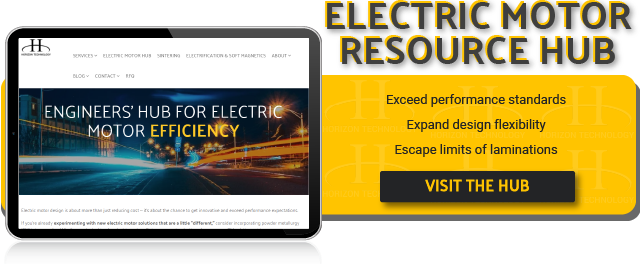The evolution of powder metal (PM) bearings, and ultimately modern powder metallurgy, dates back to the late 1920s when the Chrysler Corporation needed a higher strength bearing for the clutch of their new inline 6-cylinder engines. During this time, they developed a sintered copper, tin, and graphite bearing with 25% porosity which was then filled with oil via vacuum impregnation. This provided greater load carrying capabilities than existing materials. Chrysler was awarded a patent on the material and processing and the modern PM industry was born.
As we approach the 100th anniversary of traditional net shape powder metallurgy, we’d like to discuss potential avenues where the industry can use its creative shape making and unique materials to push innovation forward.
Let’s take a look at magnetic bearings and the potential benefits that soft magnetic composites (SMCs) may offer in meeting performance expectations in particular, those motors with either high speed or high horsepower requirements, while minimizing costs.
The Journey to Magnetic Bearings
The evolution of PM bearings was targeted to give them more value, with higher strength and lower frictional characteristics. Since the early sintered bronze bearings, the PM industry has developed new bearings grades, such as:
- Diluted bronze bearings, where the initial bronze is diluted with iron powder to reduce the cost of the raw material
- Sintered iron
- Sintered iron graphite
- Sintered iron copper graphite
Currently, PM bearings are frequently found in power tools, appliances, low power automotive equipment, as well as lawn and garden equipment. In these applications, the shaft speeds are relatively low and the loads are also low. Per the MPIF (Metal Powder Industries Federation) standard, if the shaft speed is in excess of 10,000 RPM and the duty cycle is continuous, then PM bearings should generally be avoided.
PM Bearings are given ratings related to the PV value, which is load pressure on the projected bearing area multiplied by the surface velocity of the shaft in ft/min. The best PM bearings have a PV rating of 50,000. As the speed increases, the acceptable load carrying capacity of the bearing decreases.
Why Magnetic Bearings?
To understand the advantages of magnetic bearings, we must first revisit the purpose of a bearing.
Let’s look at an electric motor. The bearings in a motor are responsible for supporting the shaft that rotates inside the motor, as well as transferring loads from the shaft to the motor. With traditional, non-magnetic bearings, a film of oil is typically used to reduce friction between the moving parts.
Simply put, bearings have two main jobs:
- Support and guide moving parts with minimal physical contact
- Reduce friction between parts with minimal power loss
One way to gauge if magnetic bearings may be beneficial for your application, is to look at the following formula:
X = rpm of motor * KWrating of motor
In the above equation, as the value of X begins to approach 1,000,000 conventional bearings become suspect and the idea of magnetic bearings becomes a more practical solution.
Magnetic bearings, typically made from expensive, rare-earth magnets, levitate the rotating shaft, allowing for motion with low friction and no mechanical wear.
Advantages of Magnetic Bearings vs. Traditional Bearings
So why use magnetic bearings? Magnetic bearings have a variety of benefits:
- Efficiency (in high-speed motors): Seals and rotating members constantly rubbing together create heat - any time heat is created, you lose efficiency. While that wear is occurring, the motor requires more energy for the rotor to turn. The friction resistance can slow down your motor. Magnetic bearings eliminate friction by supporting parts without physical contact.
- Low maintenance: Traditional bearings require a thin layer of oil to lessen friction and wear … oil that can be difficult to keep in place when spinning at high RPM. Frictionless magnetic bearings, however, generate forces in radial and axial directions to support the shaft, eliminating the need for lubrication.
- Shape: PM allows for additive shape-making for complex and unique geometries. Other processes, such as milling and grinding, are more wasteful and convoluted to achieve a comparable shape.
- Durability: Magnetic bearings last a lot longer than their non-magnetic counterparts because less friction = less wear.
SMCs: A Potential to Reduce the Need for Rare Earth Magnets
In this visual illustration of a permanent magnet solution to magnetic bearings, you can see there is oscillation in the shaft, which may be a potential limitation of this design.
What if, with an SMC approach, you could fine tune the magnetic levitating field to minimize the oscillations of the rotor, creating a more efficient design?
For the Future
If you’re looking for a bearing that can withstand high speeds, with low friction and wear, magnetic bearings may be a possibility for your next project. Now if you’re interested in:
…consider partnering with someone who can help you benefit from the advantages offered by SMC materials.
If you’re looking for a partner to help you truly reimagine your next application, Horizon Technology is innovating everyday in areas such as:
- SMC stator and rotor design
- Sintered soft magnetic - electronic suspension, motor mount, solenoid design
- High performance/high strength structural applications
For more information, please check out our Engineer’s Hub for Motor Efficiency.



